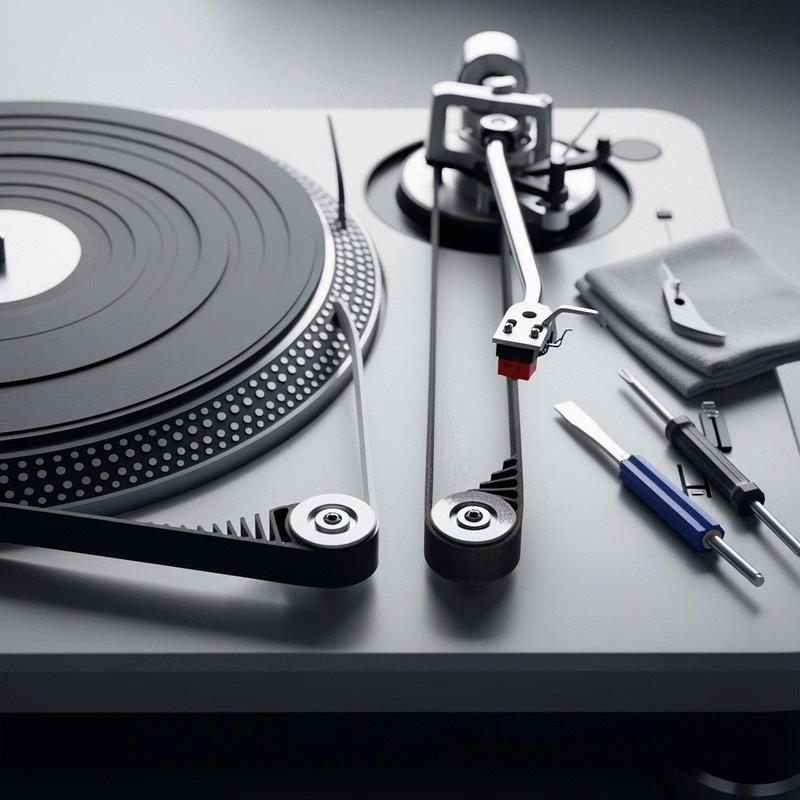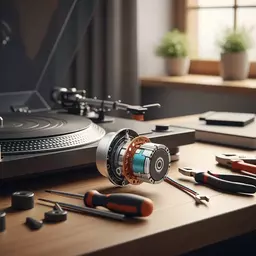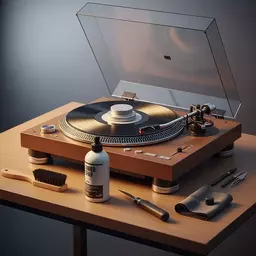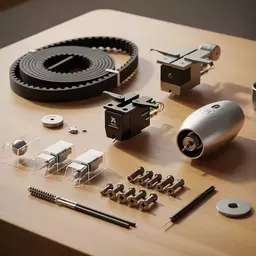Turntable Belt Problems and Solutions

Have you ever noticed how a worn turntable belt can transform your beloved vinyl experience into a frustrating one? Understanding the components and maintenance of your turntable is crucial for preserving that rich, warm sound.
What You Will Learn
- How to identify common signs of turntable belt problems such as speed inconsistencies and visible wear.
- The importance of correct belt installation for optimal performance.
- Key factors that contribute to belt wear, including age, usage, and environmental conditions.
- Best practices for maintaining your turntable, ensuring a longer lifespan for both the belt and the turntable itself.
- Understanding the roles of key turntable components to enhance troubleshooting skills.
- Answers to frequently asked questions about turntable maintenance and when to seek professional help.
Turntable Belt Issues & Maintenance Overview
Understanding common turntable belt problems and maintaining your equipment can significantly enhance your vinyl listening experience. This visual breaks down the key aspects of identifying issues, their causes, and essential maintenance steps.
Identifying Belt Issues
- • Speed inconsistencies (worn/stretched belt)
- • Slipping (platter not spinning steadily)
- • Visual wear (cracks, fraying, discoloration)
Common Causes of Worn Belts
- • Age (all belts have a shelf life)
- • Usage (frequent listening accelerates wear)
- • Environmental conditions (temp/humidity degrade material)
Proper Belt Installation
- • Snug fit (not too tight, allows smooth movement)
- • Properly seated (on motor pulley & platter)
- • No twists or kinks
Preventive Maintenance
- • Proper Storage (away from sun/humidity)
- • Gentle Handling (avoid bumps/drops)
- • Regular Use (prevents parts from seizing)
- • Environmental Control (consistent temp, low dust)
Understanding Common Turntable Belt Problems
As an audiophile, I understand how important the integrity of your turntable is for achieving that rich, warm sound we all love. One vital component in ensuring your turntable performs at its best is the turntable belt. Unfortunately, belt issues can arise, affecting the playback quality of your records. In this section, we’ll explore how to identify common turntable belt problems and why proper maintenance is crucial.
Identifying Turntable Belt Issues: Signs to Look For
Recognizing the signs of belt problems can save you time and frustration down the line. Here are some common symptoms to watch out for:
- Speed inconsistencies: If your records are playing faster or slower than normal, this could indicate a worn or stretched belt. For more in-depth information on diagnosing turntable speed issues, you can refer to Korfaudio's guide on turntable problems.
- Slipping: If the platter isn't spinning steadily or if you hear a slippage sound, it’s time to take a closer look.
- Visual wear: Check for cracks, fraying, or discoloration in the belt itself.
By keeping an eye out for these symptoms, you can effectively troubleshoot your turntable’s performance issues and enjoy your vinyl collection without interruptions.
The Importance of Proper Belt Installation
Did you know that improper belt installation can severely impact your turntable's performance? If the belt is misaligned or positioned incorrectly, it can lead to uneven platter rotation and sound distortion. Here are some tips for ensuring your belt is installed correctly:
- Make sure the belt fits snugly but not too tight, allowing for smooth movement.
- Ensure the belt is seated properly on both the motor pulley and the platter.
- Double-check that there are no twists or kinks in the belt.
Taking the time to correctly install your turntable belt can make a significant difference in sound quality. Remember, a well-aligned belt is essential for optimal playback!
Common Causes of Worn Belts and Their Effects
Over time, all turntable belts will experience wear, but understanding the common causes can help you prolong their lifespan. Here are some typical factors that lead to belt wear:
- Age: All belts have a shelf life. The older the belt, the more likely it is to stretch or crack.
- Usage: Frequent use can accelerate wear, especially for those who listen to records regularly.
- Environmental conditions: High temperatures or humidity can degrade the material, leading to faster deterioration. If your turntable is not spinning, KBAudio offers insights into why your turntable might not be spinning, including belt-related issues.
Being aware of these factors will help you maintain your turntable more effectively and ensure that your audio experience remains enjoyable. Regular checks and prompt replacements can keep your belt in top shape!
Pro Tip
Regularly check your turntable's belt tension to ensure optimal performance. A belt that is too loose can lead to speed inconsistencies, while a belt that is too tight may cause unnecessary wear on both the belt and the motor. Aim for a snug fit that allows for smooth movement, and your turntable will thank you!
Maintaining Your Turntable for Optimal Performance
Keeping your turntable in top shape is essential for enjoying the rich tones of your vinyl records. Regular maintenance not only helps prevent issues but also prolongs the life of your beloved music machine. In this section, we'll explore some effective preventive maintenance strategies that will keep your turntable spinning smoothly!
Preventive Maintenance Strategies
To ensure your turntable remains a treasured part of your audio experience, it's important to adopt a few simple habits. Here are some preventive maintenance strategies to consider:
- Proper Storage: Store your turntable in a stable environment, away from direct sunlight and humidity, to protect its delicate components.
- Gentle Handling: Always handle your turntable with care, avoiding bumps or drops that could misalign crucial parts.
- Regular Use: Don't let your turntable sit idle for too long; regular use helps keep everything functioning as it should.
- Environmental Control: Maintain a consistent temperature and low dust levels in your space to prevent wear and tear on both your turntable and records.
By implementing these maintenance strategies, you can significantly extend the life of your turntable belt and other components, ensuring a smoother audio experience!
Understanding Turntable Components and Their Roles
To truly appreciate your turntable, it's important to understand the roles of its various components. Each part contributes to the overall functionality and audio quality. Let's break down some key components:
- Idler Wheel: This component transfers power from the motor to the platter, affecting speed and stability.
- Tonearm: The tonearm holds the cartridge and stylus, and its alignment is crucial for optimal playback quality. For more comprehensive information on common turntable problems and troubleshooting, refer to Origin Live's turntable support page.
- Motor: A well-functioning motor is essential for maintaining consistent platter speed and performance.
- Platter: The platter is where your records sit; its weight and material can impact sound quality.
Understanding these components can help you diagnose issues more effectively and appreciate the nuances of analog sound! Remember, as an audiophile, every detail matters!
Addressing Frequently Asked Questions
Many of you might have questions about maintaining your turntable and addressing belt problems. Here are some common queries I receive, along with quick answers:
Frequently Asked Questions
- Q: How often should I inspect my turntable belt for wear?
A: It's a good practice to visually inspect your turntable belt every 3-6 months, especially if you use your turntable frequently. Look for cracks, fraying, stretching, or discoloration. - Q: What are the immediate signs that my turntable belt needs to be replaced?
A: The most immediate signs include noticeable speed inconsistencies (records playing too fast or too slow), audible slipping sounds, or if the platter struggles to reach or maintain speed. - Q: Can environmental factors really affect my turntable belt?
A: Yes, absolutely. Extreme temperatures, high humidity, and even direct sunlight can cause the rubber material of the belt to degrade, leading to stretching, cracking, or loss of elasticity. - Q: Is it possible for a brand-new belt to cause problems?
A: While less common, a new belt can cause issues if it's the wrong size, improperly installed (too tight, too loose, or twisted), or made of a lower-quality material. Always ensure you purchase the correct belt for your specific turntable model. - Q: Beyond the belt, what other components should I regularly check for optimal turntable performance?
A: Besides the belt, regularly check your stylus for wear, ensure your tonearm is properly balanced, and keep the platter bearing lubricated (using appropriate lubricants). Dust and debris can also impact performance, so regular cleaning is essential.
These FAQs cover some common concerns, but remember, I'm always here to help you troubleshoot any issues with your turntable! Don't hesitate to reach out if you have more questions.
Final Thoughts on Turntable Belt Issues
Knowing When to Seek Professional Help
While many turntable issues can be resolved through DIY methods, sometimes you may need to call in the experts. If you’ve tried troubleshooting without success, or if you encounter complex problems like motor alignment issues, it might be time to seek professional help. Don’t hesitate to reach out to services like Turntable Repair Australia for expert assistance!
Your Path to a Better Turntable Experience
Taking care of your turntable with proper maintenance and attention will greatly enhance your listening experience! Apply the maintenance tips and troubleshooting techniques we've discussed, and you'll soon find that your records sound better than ever. Remember, every time you spin a vinyl, you're rediscovering the beauty of analog sound—let's keep it that way!
Recap of Key Points
Here is a quick recap of the important points discussed in the article:
- Signs of Belt Issues: Look for speed inconsistencies, slipping sounds, and visual wear on the belt.
- Proper Installation: Ensure the belt fits snugly, is seated correctly, and has no twists or kinks.
- Common Causes of Wear: Be aware of factors like age, usage frequency, and environmental conditions that can degrade the belt.
- Preventive Maintenance: Store properly, handle gently, use regularly, and control environmental factors for optimal performance.
- Understanding Components: Familiarize yourself with key parts like the idler wheel, tonearm, motor, and platter for effective troubleshooting.
- When to Seek Help: If DIY methods fail or complex issues arise, don't hesitate to consult professionals for assistance.
Popular Posts
 Are you ready to elevate your turntable's performance? Understanding the nuances of motor replacemen
Are you ready to elevate your turntable's performance? Understanding the nuances of motor replacemen
 Have you ever wondered how a little maintenance can dramatically enhance your turntable's performanc
Have you ever wondered how a little maintenance can dramatically enhance your turntable's performanc
 Have you ever found yourself frustrated with a turntable that just won't play right? The good news i
Have you ever found yourself frustrated with a turntable that just won't play right? The good news i
 Have you ever considered how the condition of your tonearm affects the music you love? Proper tonear
Have you ever considered how the condition of your tonearm affects the music you love? Proper tonear
